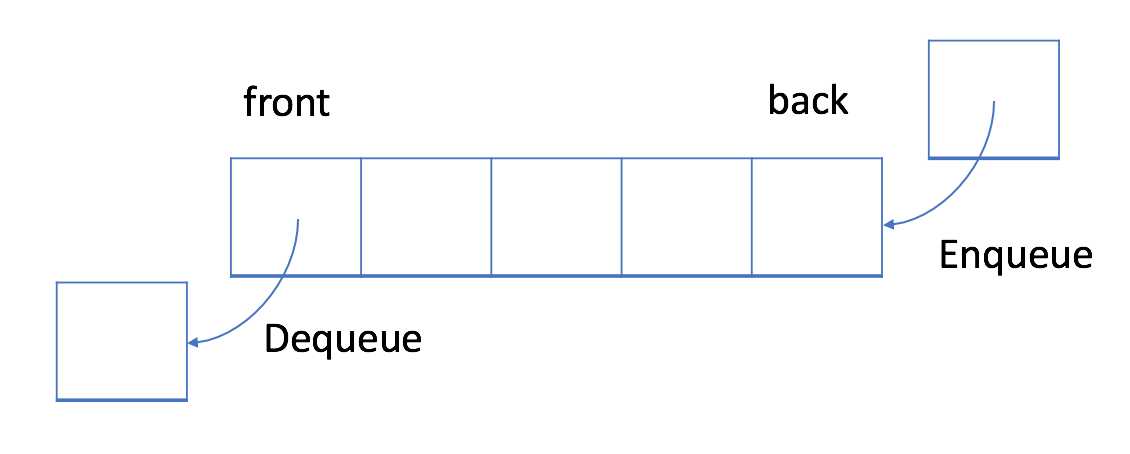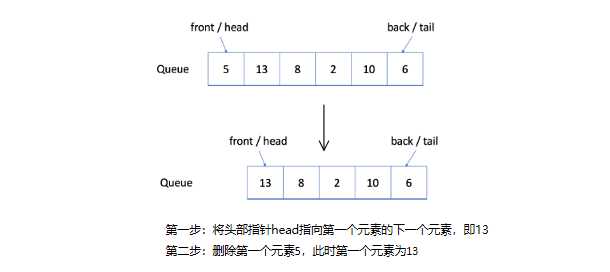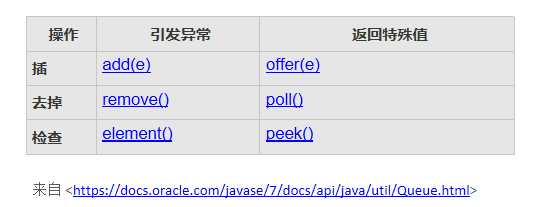數據結構:隊列
阿新 • • 發佈:2018-10-05
turn docs size ces 限制 color 操作 nbsp oid
數據結構:隊列
先入先出的數據結構
說明

在先入先出數據結構中,將首先處理隊列中的第一個元素,即front所指的位置元素。
如上圖所示,隊列是典型的 FIFO 數據結構。插入(insert)操作也稱作入隊(enqueue),新元素始終被添加在隊列的末尾。 刪除(delete)操作也被稱為出隊(dequeue)。 你只能移除第一個元素。
示例
入隊操作

出隊操作

隊列實現
為了實現隊列,我們可以使用動態數組和指向隊列頭部的索引。
如上所述,隊列應支持兩種操作:入隊和出隊。入隊會向隊列追加一個新元素,而出隊會刪除第一個元素。 所以我們需要一個索引來指出起點。
// "static void main" must be defined in a public class.
class MyQueue {
// store elements
private List<Integer> data;
// a pointer to indicate the start position
private int p_start;
public MyQueue() {
data = new ArrayList<Integer>();
p_start = 0;
}
/** Insert an element into the queue. Return true if the operation is successful. */
public boolean enQueue(int x) {
data.add(x);
return true;
};
/** Delete an element from the queue. Return true if the operation is successful. */
public boolean deQueue() {
if (isEmpty() == true) {
return false;
}
p_start++;
return true;
}
/** Get the front item from the queue. */
public int Front() {
return data.get(p_start);
}
/** Checks whether the queue is empty or not. */
public boolean isEmpty() {
return p_start >= data.size();
}
};
public class Main {
public static void main(String[] args) {
MyQueue q = new MyQueue();
q.enQueue(5);
q.enQueue(3);
if (q.isEmpty() == false) {
System.out.println(q.Front());
}
q.deQueue();
if (q.isEmpty() == false) {
System.out.println(q.Front());
}
q.deQueue();
if (q.isEmpty() == false) {
System.out.println(q.Front());
}
}
}
上面的實現很簡單,但在某些情況下效率很低。 隨著起始指針的移動,浪費了越來越多的空間。 當我們有空間限制時,這將是難以接受的。

如果我們出隊了一個元素,此時第一個位置將空出來,這個空間的浪費我們可以使用循環隊列來解決。
循環隊列
說明
循環隊列是一種線性數據結構,其操作表現基於 FIFO(先進先出)原則並且隊尾被連接在隊首之後以形成一個循環。它也被稱為“環形緩沖器”。
循環隊列的一個好處是我們可以利用這個隊列之前用過的空間。在一個普通隊列裏,一旦一個隊列滿了,我們就不能插入下一個元素,即使在隊列前面仍有空間。但是使用循環隊列,我們能使用這些空間去存儲新的值。
實現
class MyCircularQueue {
private int[] data;
private int head;
private int tail;
private int size;
/** Initialize your data structure here. Set the size of the queue to be k. */
public MyCircularQueue(int k) {
data = new int[k];
head = -1;
tail = -1;
size = k;
}
/** Insert an element into the circular queue. Return true if the operation is successful. */
public boolean enQueue(int value) {
if (isFull() == true) {
return false;
}
if (isEmpty() == true) {
head = 0;
}
tail = (tail + 1) % size;
data[tail] = value;
return true;
}
/** Delete an element from the circular queue. Return true if the operation is successful. */
public boolean deQueue() {
if (isEmpty() == true) {
return false;
}
if (head == tail) {
head = -1;
tail = -1;
return true;
}
head = (head + 1) % size;
return true;
}
/** Get the front item from the queue. */
public int Front() {
if (isEmpty() == true) {
return -1;
}
return data[head];
}
/** Get the last item from the queue. */
public int Rear() {
if (isEmpty() == true) {
return -1;
}
return data[tail];
}
/** Checks whether the circular queue is empty or not. */
public boolean isEmpty() {
return head == -1;
}
/** Checks whether the circular queue is full or not. */
public boolean isFull() {
return ((tail + 1) % size) == head;
}
}
/**
* Your MyCircularQueue object will be instantiated and called as such:
* MyCircularQueue obj = new MyCircularQueue(k);
* boolean param_1 = obj.enQueue(value);
* boolean param_2 = obj.deQueue();
* int param_3 = obj.Front();
* int param_4 = obj.Rear();
* boolean param_5 = obj.isEmpty();
* boolean param_6 = obj.isFull();
*/隊列用法
除基本Collection操作外,隊列還提供額外的插入,提取和檢查操作。這些方法中的每一種都以兩種形式存在:一種在操作失敗時拋出異常,另一種返回特殊值(null或false,具體取決於操作)。後一種形式的插入操作專門用於容量限制的隊列 實現; 在大多數實現中,插入操作不會失敗。

// "static void main" must be defined in a public class.
public class Main {
public static void main(String[] args) {
// 1. Initialize a queue.
Queue<Integer> q = new LinkedList();
// 2. Get the first element - return null if queue is empty.
System.out.println("The first element is: " + q.peek());
// 3. Push new element.
q.offer(5);
q.offer(13);
q.offer(8);
q.offer(6);
// 4. Pop an element.
q.poll();
// 5. Get the first element.
System.out.println("The first element is: " + q.peek());
// 7. Get the size of the queue.
System.out.println("The size is: " + q.size());
}
}
數據結構:隊列

